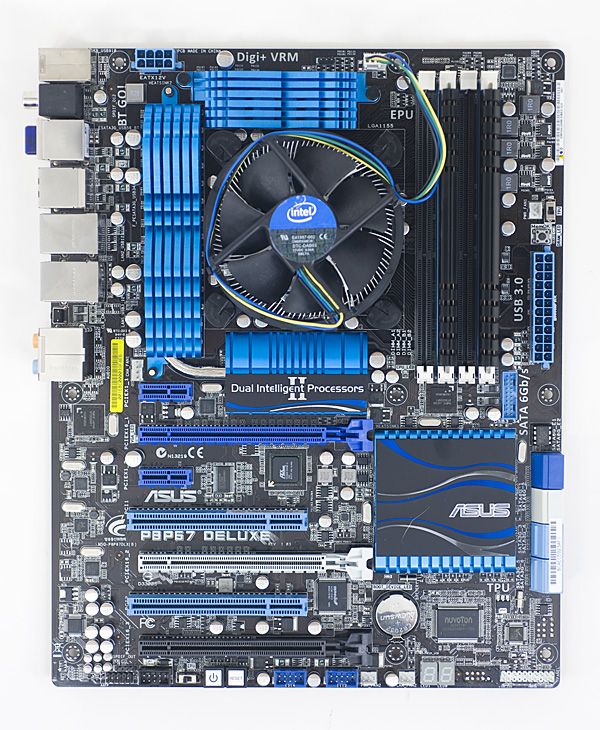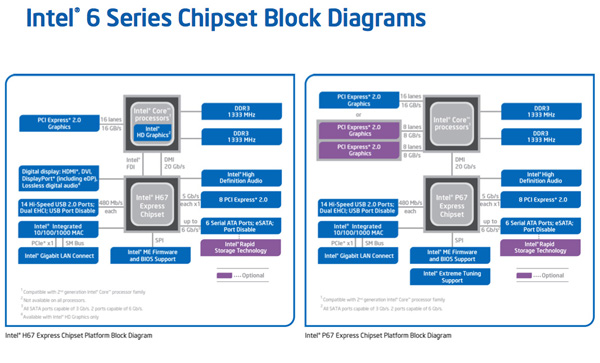The Source of Intel's Cougar Point SATA Bug
by Anand Lal Shimpi on January 31, 2011 6:05 PM EST- Posted in
- CPUs
- Intel
- Sandy Bridge
- Recall
I just got off the phone with Intel’s Steve Smith (VP and Director of Intel Client PC Operations and Enabling) and got some more detail on this morning’s 6-series chipset/SATA bug.
The Problem
Cougar Point (Intel’s 6-series chipsets: H67/P67) has two sets of SATA ports: four that support 3Gbps operation, and two that support 6Gbps operation. Each set of ports requires its own PLL source.
The problem in the chipset was traced back to a transistor in the 3Gbps PLL clocking tree. The aforementioned transistor has a very thin gate oxide, which allows you to turn it on with a very low voltage. Unfortunately in this case Intel biased the transistor with too high of a voltage, resulting in higher than expected leakage current. Depending on the physical characteristics of the transistor the leakage current here can increase over time which can ultimately result in this failure on the 3Gbps ports. The fact that the 3Gbps and 6Gbps circuits have their own independent clocking trees is what ensures that this problem is limited to only ports 2 - 5 off the controller.
You can coax the problem out earlier by testing the PCH at increased voltage and temperature levels. By increasing one or both of these values you can simulate load over time and that’s how the problem was initially discovered. Intel believes that any current issues users have with SATA performance/compatibility/reliability are likely unrelated to the hardware bug.
One fix for this type of a problem would be to scale down the voltage applied across the problematic transistor. In this case there’s a much simpler option. The source of the problem is actually not even a key part of the 6-series chipset design, it’s remnant of an earlier design that’s no longer needed. In our Sandy Bridge review I pointed out the fair amount of design reuse that was done in creating the 6-series chipset. The solution Intel has devised is to simply remove voltage to the transistor. The chip is functionally no different, but by permanently disabling the transistor the problem will never arise.
To make matters worse, the problem was inserted at the B-stepping of the 6-series chipsets. Earlier steppings (such as what we previewed last summer) didn’t have the problem. Unfortunately for Intel, only B-stepping chipsets shipped to customers. Since the fix involves cutting off voltage to a transistor it will be fixed with a new spin of metal and you’ll get a new associated stepping (presumably C-stepping?).
While Steve wouldn’t go into greater detail he kept mentioning that this bug was completely an oversight. It sounds to me like an engineer did something without thinking and this was the result. This is a bit different from my initial take on the problem. Intel originally characterized the issue as purely statistical, but the source sounds a lot more like a design problem rather than completely random chance.
It’s Notta Recall
Intel has shipped around 8 million 6-series chipsets since the launch at CES. It also committed to setting aside $700 million to deal with the repair and replacement of any affected chipsets. That works out to be $87.50 per chipset if there are 8 million affected chipsets in the market, nearly the cost of an entire motherboard. Now the funds have to cover supplying the new chipset, bringing in the affected motherboard and repairing it or sending out a new one. Intel can eat the cost of the chipset, leaving the $87.50 for shipping, labor and time, as well as any other consideration Intel provides the OEM with (here’s $5, don’t hate us too much). At the end of the day it seems like enough money to handle the problem. However Intel was very careful to point out that this is not a full blown recall. The why is simple.

If you have a desktop system with six SATA ports driven off of P67/H67 chipset, there’s a chance (at least 5%) that during normal use some of the 3Gbps ports will stop working over the course of 3 years. The longer you use the ports, the higher that percentage will be. If you fall into this category, chances are your motherboard manufacturer will set up some sort of an exchange where you get a fixed board. The motherboard manufacturer could simply desolder your 6-series chipset and replace it with a newer stepping if it wanted to be frugal.
If you have a notebook system with only two SATA ports however, the scenario is a little less clear. Notebooks don’t have tons of storage bays and thus they don’t always use all of the ports a chipset offers. If a notebook design only uses ports 0 & 1 off the chipset (the unaffected ports), then the end user would never encounter an issue and the notebook may not even be recalled. In fact, if there are notebook designs currently in the pipeline that only use ports 0 & 1 they may not be delayed by today’s announcement. This is the only source of hope if you’re looking for an unaffected release schedule for your dual-core SNB notebook.
Final Words
Intel maintains that Sandy Bridge CPUs are not affected, and current users are highly unlikely to encounter the issue even under heavy loads. So far Intel has only been able to document the issue after running extended testing at high temperatures (in a thermal chamber) and voltages. My recommendation is to try to only use ports 0 & 1 (the 6Gbps ports) on your 6-series motherboard until you get a replacement in place.
OEMs and motherboard manufacturers are going to be talking to Intel over the next week to figure out the next steps. Intel plans to deliver fixed silicon to its partners at the end of February, however it’ll still take time for the motherboard makers to turn those chips into products. I wouldn’t expect replacements until March at the earliest.
I maintain that the best gesture of goodwill on Intel’s part would be to enable motherboard manufacturers to replace P67/H67 motherboards with Z68 boards for those users who want them.











127 Comments
View All Comments
JasperJanssen - Tuesday, February 1, 2011 - link
Yes, spend too much for an X58 system that is already outdated, great idea.WhoBeDaPlaya - Tuesday, February 1, 2011 - link
Much as I love my X58, it doesn't make any kind of sense to dump ~$350 (minimum - $200 MC Nehalem special + mobo) into it when you can get a 2500K combo for $280 + tax at MC.cactusdog - Saturday, February 5, 2011 - link
It also doesnt make sense to buy a P67 board when Z68 are coming out soon. The true overclocking boards for the socket 1155 platform.banzaigtv - Wednesday, February 2, 2011 - link
I'm in the same boat as you, but I'm purchasing an OEM system. You can get the AMD Phenom II X6 1100T or the Intel Core i7 980X for fast performance. Unless the SB systems make a comeback by the end of this month, I'm getting a PC with an AMD Phenom II X6 processor or perhaps an Intel Core i7 930 or 950.bavaria2 - Monday, January 31, 2011 - link
Why exchange the chip when motherboard manufacterers can simply take the chip, put an additional sata controller to the board and use the 2 6G ports from the chip and the other 4 ports from the additional sata controller.The mobo manufacturers can take the layout for boards with additional sata chip from their premium versions.
- There is a much shorter delay,
- The chips are not wasted and can be reused
- It costs only a few $ for a sata chip and slightly different mobo instead of 87,50$
- Intel could even continue production of the chips, just selling them a few $ cheaper
Of course it only works for chips not already used on mobos yet.
JasperJanssen - Tuesday, February 1, 2011 - link
The chips aren't worth anything. Any chips that have not made it into boards are already landfill, or will be by the end of the week. A chipset has a manufacturing cost to Intel of somewhere like 10 bucks at most.87.50 is an average, and that includes the cost to replace motherboards in desktops and laptops, which can be a lot more than a measly hundred bucks.
CZroe - Monday, January 31, 2011 - link
Intel could always repurpose the old chips for notebooks and SFF PCs that only offer 2xSATA ports. Many countries have laws prohibiting the sale of such used/remanufactured items in new products, but they could always be used for something like charity notebooks for third-world countries... like a Sandy Bridge version of the OLPCs. ;)Touche - Monday, January 31, 2011 - link
"Intel claims that only 5-percent of Sandy Bridgeowners will experience the flaw. But speaking with
manufacturers, we were told that numbers appear
to be far greater than that. Some companies told us
that this is definitely a "panic-mode" situation for
them."
www.tomshardware.com/news/sandy-bridge-sata-error-sata-3,12112.html
cactusdog - Monday, January 31, 2011 - link
It will be interesting to see how folks like Asus and Gigabyte will handle this. Will the end user be forced into the traditional method of replacing the motherboard, ie the end user sends off their board and waits for up to 8 weeks for the replacement?? If so, that would be very disappointing.Boards should be swappable at the point of sale. Maybe Anand can ask Gary how Asus plan to handle this.
travman733 - Monday, January 31, 2011 - link
Within two days of my P67-based board running a SATA II port died. Plugged my DVD drive into another port and so-far so-good. Yes, it sucks that we're stuck in situation, but for me personally I wouldn't have a problem just getting an expansion card supporting four SATA II devices. I hate to see my board being scrapped for this, but I do also need a permanent resolution whether it be a new board or expansion card.